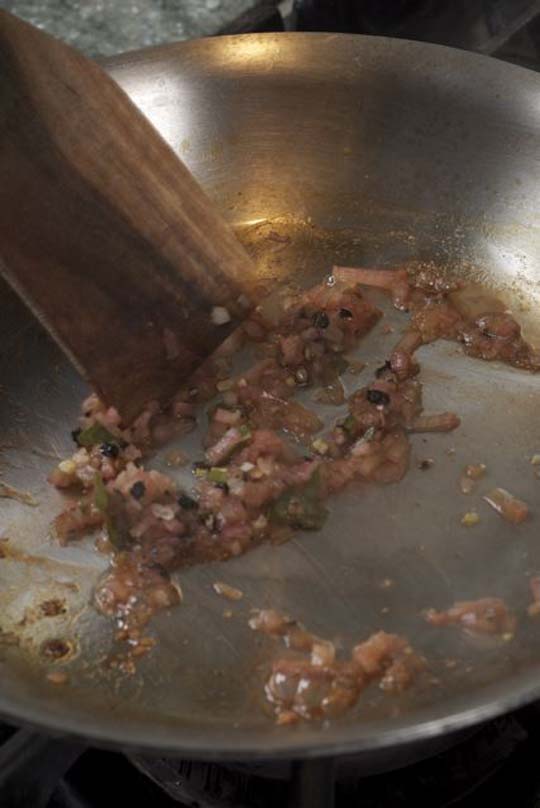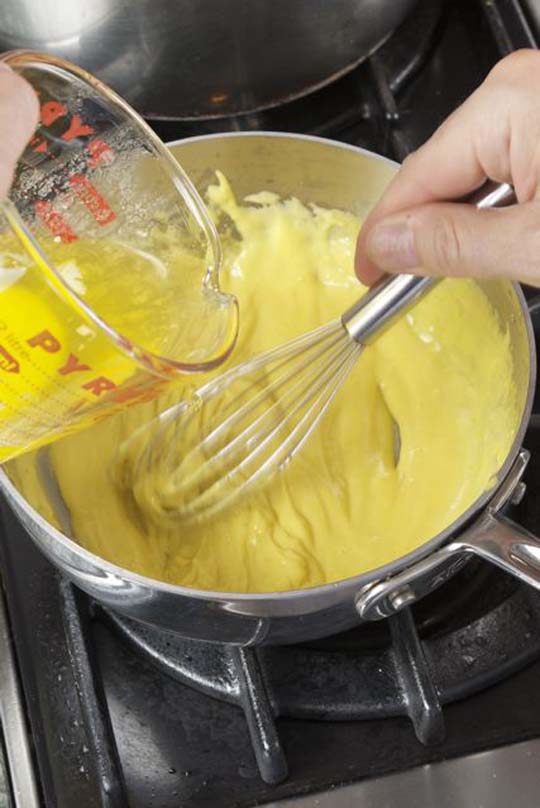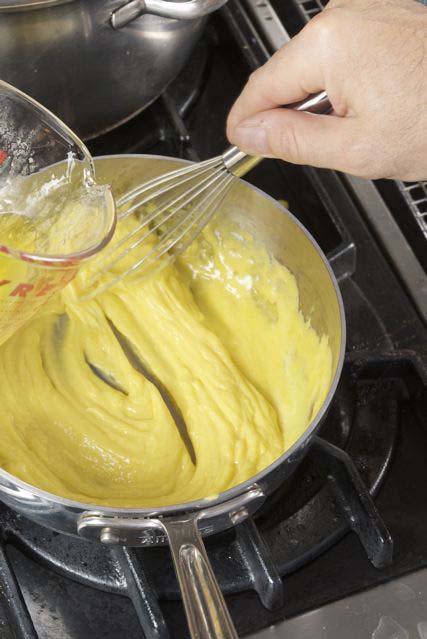
Many people are afraid of hollandaise sauce, are you? Some think eating it will make them fat. (It will if you eat it every day, so don’t eat it every day.) If you are like me, the thought of making hollandaise conjures up visions of toque clad chefs with big bowls and even bigger whisks swearing because the beautiful sauce they have spent the last several minutes vigorously whisking has separated on them, “Merde!”
I have been desperately afraid of making this sauce since forever. (Not afraid of eating it mind you, I’ve never met an eggs benedict I didn’t like, or eat.) To overcome this fear I asked my friend Hank to show me how to make it.
OMG. Hank’s hollandaise didn’t separate, and he didn’t swear (any more than usual), but the work! The beads of sweat forming on this man’s forehead as he whipped those egg yolks and butter into submission. I was dreading the attempt. Hank has arms of steel. I have arms of, hmmm, a young, willowy sapling? Whatever. Not steel.
The solution? Blender hollandaise. It’s easy! Even I can do it. Which means even you can do it. So I encourage you to try it, if you like me have been intimidated by the thought of attempting this sauce. Use it over fish, steamed vegetables like broccoli or asparagus, or on top of poached eggs, bacon, and English muffins.The key is to make sure it’s got enough water in it; water keeps the oil droplets separate, which is why the sauce is thick and opaque and so lovely to eat.
Ingredients are as follows, the recipe, ratio and variations on it are in Ratio; I’ll describe method with pix below: 1 tablespoon minced shallot, 10 or so peppercorns, cracked, a crumpled bay leaf (parsley, thyme if you have some), three-fingered pinch of salt, 1/4 cup good vinegar, 3 egg yolks, lemon juice to taste (1 to 3 teaspoons), 8 ounces (two sticks) of butter melted in vessel you can pour it from in a thin stream, cayenne to taste (optional).
First make the reduction, which is the step that gives the Hollandaise its unique flavor (otherwise it’s just lemon butter, which is good, but not traditional Hollandaise). Combine the shallot, cracked pepper, bay leaf, salt and vinegar in a pan and simmer it till it’s dry (you’ll sometimes see this referred to as sec, the French term).Notice I’ve just roughly chopped the shallots; they’ll be strained out later. You do want them small enough to impart their flavor however in the brief time they’re cooked.

This is the reduction taken to sec. All the strong acidity is gone, leaving only the flavors, and a little caramelization in the pan. Now you need to capture those flavors by adding the amazing ingredient we call water to the pan, about a quarter cup. Bring it to a simmer, and strain it into a sauce pan. Taste this, so you know what you’re talking about. Add the egg yolks to the reduction (top photo).
Next step is to cook the yolks. This gives them volume and changes their flavor (it should kill any bad bacteria too if you’re using industrial eggs; I highly recommend organic if they’re available). Eggs are best cooked over simmering water but any heat will do, just keep it low. You don’t want scrambled eggs. I hold a pan in a pot filled with simmering water; this allows me to control the heat easily. Add a good squeeze of lemon juice here. They’re done when you can see that if you cooked them more, they’d be hard, not creamy. Don’t over think it and don’t worry about under cooking the eggs. You can over cook them, though.

Traditional Hollandaise uses clarified butter. I simply melt my butter in the microwave, spoon off the froth at the top and pour all the clear butter fat directly into the cooked yolks off the heat. You don’t need to cook this sauce anymore. As with a mayonnaise you need to first add just a few drops of the melted butter, whisking it in quickly to establish your emulsification. Once it’s going you can pour butter in a steady stream, whisking continuously, till all the butter’s in. Don’t worry if some of the watery whey goes in as well, it can only help (I discard what’s left when all the butter’s in).

This is the most important photo of the bunch. Notice how the sauce has become rough on the surface? This is right before it’s going to break. When I see this, I dribble in some cool water. The sauce immediately smooths out. Again, if it breaks, put a teaspoon of water in a clean bowl and start whisking again. I’ve never lost a best of three with an emulsified sauce. When the butter is in, taste it, add some more lemon (it should be distinctly lemony), and I add a pinch of cayenne.

We had some beautiful asparagus from the market, which is why I made the Hollandaise (that and Elise’s suggestion!). It’s beautiful with artichokes, on fish, on eggs. I love a good Hollandaise sauce. It should be part of the first from scratch challenge, suggested by Matthew and a few others. Eggs Benedict. Doesn’t require a growing season. A starter challenge. Details to come. Until then grab up the remaining asparagus while it lasts and serve it with a traditional thick Hollandaise.
Update: Thoughts and comment following questions in comments here and on Twitter, 6/16:
Many people have questioned the reduction in this Hollandaise, even the redoubtable Hunger Artist, so clearly this is worth addressing. Some reliable sources, from Larousse to St. Julia, use only lemon juice for flavoring. Again, as there are no absolutes this is fine. I’m sticking with using a reduction for a few reasons. First, because Escoffier, the first person to codify and classify contemporary French cuisine in Le Guide Culinaire, includes a reduction in his Hollandaise. That alone seals the deal for me as he created the standard. Second, it was the way I was taught it at The Culinary Institute of America, which prides itself on fundamentals and tradition. Third, and equal if not more important than reasons one and two: it tastes better, more complex, more interesting, has more depth.
So, my bottom line is a traditional Hollandaise does use a reduction (and besides it’s a fun technique to have in your arsenal). But: a Hollandaise made only with butter, egg yolk and lemon, is justifiably called Hollandaise as well (as opposed to, say, vodka and vermouth being called a martini).
A correction: Julia Child does give a blender Hollandaise technique in her landmark book, so she is likely the first to publish it (if anyone knows different, please say so).
And finally, the difference between a Hollandaise and a Bearnaise is that a Hollandaise has no tarragon. Bearnaise has abundant tarragon. I use good fresh dried tarragon in the reduction, and add plenty of fresh chopped tarragon just before serving.
Update: Reheating Hollandaise
A couple people have commented on reusing Hollandaise. If you have left over Hollandaise, you canrefrigerate it and reuse it. To reuse, melt it in a microwave, then simply reemulsify it into a little bit of water, just the way you would fix a broken sauce.
Easy Blender Hollandaise Sauce RecipeIngredients
Method
1 Melt the butter slowly in a small pot. Try not to let it boil – you want the moisture in the butter to remain there and not steam away.
2 Add the egg yolks, lemon juice, salt and cayenne (if using) into your blender. Blend the egg yolk mixture at a medium to medium high speed until it lightens in color, about 20-30 seconds. The friction generated by the blender blades will heat the yolks a bit. The blending action will also introduce a little air into them, making your hollandaise a bit lighter.
3 Once the yolks have lightened in color, turn the blender down to its lowest setting (if you only have one speed on your blender it will still work), and drizzle in the hot melted butter slowly, while the blender is going. Continue to buzz for another couple seconds after the butter is all incorporated.
4 Turn off the blender and taste the sauce. It should be buttery, lemony and just lightly salty. If it is not salty or lemony enough, you can add a little lemon juice or salt to taste. If you want a thinner consistency, add a little warm water. Pulse briefly to incorporate the ingredients one more time.
Store until needed in a warm spot, like on or next to the stovetop. Use within an hour or so.
Hello! All photos and content are copyright protected. Please do not use our photos without prior written permission. If you wish to republish this recipe, please rewrite the recipe in your own unique words and link back to the source recipe here on Simply Recipes. Thank you!
Read more: http://www.simplyrecipes.com/recipes/easy_blender_hollandaise_sauce/#ixzz3ZpRXEKfl Sweet Potato Hash Browns Continue reading "Sweet Potato Hash Browns" » EASY Italian Sausage Spaghetti |
Monday, 11 May 2015
Easy Blender Hollandaise Sauce
Subscribe to:
Post Comments (Atom)
No comments:
Post a Comment